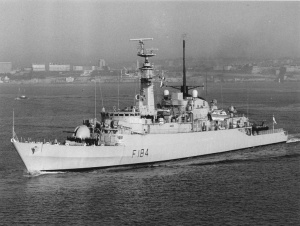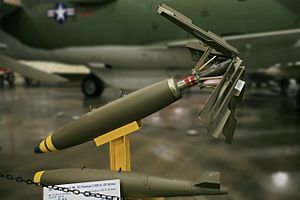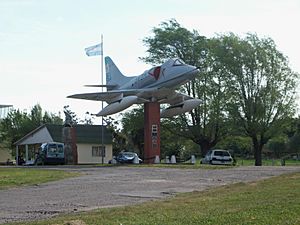HMS Ardent (F184) facts for kids

HMS Ardent
|
|
Quick facts for kids History |
|
|---|---|
| Name | HMS Ardent |
| Operator | Royal Navy |
| Ordered | 17 April 1973 |
| Builder | Yarrow Shipbuilders |
| Laid down | 26 February 1974 |
| Launched | 9 May 1975 |
| Commissioned | 13 October 1977 |
| Homeport | HMNB Devonport |
| Identification | Pennant number: F184 |
| Motto | Through fire and water |
| Fate | Sunk by Argentine aircraft on 22 May 1982 |
| General characteristics | |
| Class and type | Type 21 frigate |
| Displacement | 3,250 tons full load |
| Length | 384 ft (117 m) |
| Beam | 41 ft 9 in (12.73 m) |
| Draught | 19 ft 6 in (5.94 m) |
| Propulsion |
|
| Speed | 32 knots (59 km/h; 37 mph) |
| Range |
|
| Complement | 177 |
| Armament |
|
| Aircraft carried | 1 × Westland Wasp helicopter, later refitted for 1 × Lynx |
HMS Ardent was a special type of warship called a frigate in the Royal Navy, the United Kingdom's navy. She was built in Scotland by Yarrow Shipbuilders Ltd. Ardent was equipped with powerful Exocet missile launchers. She played a part in the Falklands War in 1982, where she was sadly sunk by Argentine aircraft on May 21, 1982, in an area called Falkland Sound.
Contents
HMS Ardent and the Falklands War
On April 19, 1982, Ardent set sail from HMNB Devonport in England. Her mission was to head towards the Falkland Islands. Along the way, she helped escort other ships that were part of the British task force. These ships were also on their way to the Falklands, stopping first at Ascension Island.
On May 9, 1982, Ardent got very close to a troopship named Canberra. She showed the soldiers on board how her guns worked. This was to prepare them for what might happen in the war zone.
The Attack on Ardent
On May 21, 1982, Ardent was in Falkland Sound. She was helping with an operation by firing her guns at an Argentine airstrip at Goose Green. While doing this, she was attacked by several waves of Argentine aircraft. These air attacks caused Ardent to sink the very next day.
The first attack happened around 4:00 PM UTC. A single Skyhawk aircraft dropped two bombs. They landed very close to the frigate, but luckily, neither of them exploded.
The main attacks began later, around 5:40 PM UTC. Ardent was told to move west with another ship, Yarmouth. This was to try and split up the incoming air attacks. A group of three aircraft, either Skyhawks or IAI Daggers, flew across the Falklands Sound. They then turned to attack Ardent from the northeast.
The Argentine planes fired their cannons and dropped three bombs. The only weapons on Ardent that worked well were her 20mm anti-aircraft cannons. The Sea Cat anti-aircraft missile system couldn't lock onto the fast-moving attackers. Even the ship's main 4.5-inch gun couldn't hit them because they flew out of its firing range.
Two bombs exploded in the ship's hangar area. This destroyed the Westland Lynx helicopter stored there. One explosion was so powerful it blew the Sea Cat missile launcher 24 meters (80 feet) into the air. It then crashed back down onto the flight deck. A third bomb went through the back of the ship but did not explode. The ship's power system was badly damaged, causing some important equipment to lose power, including the main gun. The hangar caught fire, and some of the crew were injured.
Even though she was badly hit, Ardent could still use her engines and steer. She was ordered to head north towards Port San Carlos. But at 6:00 PM UTC, five more Skyhawk aircraft attacked. They dropped many bombs. Several bombs exploded near the back of the ship, causing more damage and some flooding.
The ship's dining hall was destroyed. Communication between the bridge (where the ship is controlled) and the control center was cut. The ship also lost its steering. This attack caused many more injuries, especially to the teams trying to put out the fires in the hangar.
Ardent eventually stopped in the shallow waters of Grantham Sound. The fires at the back of the ship were now completely out of control. With the ship leaning heavily to one side, Commander Alan West, the captain, gave the order to abandon ship. The Yarmouth came alongside to rescue the survivors. The crew was then taken to the troopship Canberra. At this point, it was known that 22 brave men had lost their lives.
Ardent continued to burn through the night, with occasional explosions. She finally sank at 6:30 AM the next day. Only her front mast remained above the water.
Heroism and Aftermath
A sailor named John Dillon showed great bravery. Despite being burned himself, he cleared debris from an injured sailor and helped him get to the top deck and into the water. Both men were rescued. For his heroic actions, John Dillon received a George Medal.
The last person to leave the sinking ship was her captain, Commander Alan West. He was later awarded the Distinguished Service Cross for his leadership. Commander West later became the head of the Royal Navy, known as the First Sea Lord, from 2002 to 2006.
Within days, navy divers removed Ardent's smaller anti-aircraft guns to use on other ships. Her remaining mast was used as a warning and a guide by her sister ship, Arrow, while Arrow was firing at Goose Green.
Today, the wreck of Ardent is a protected area under the Falkland Islands Protection of Wrecks Act. This means it is illegal to disturb the wreck.
Argentine Air Attacks Details
The Argentine Air Force reported two main attacks on Ardent:
- At 2:00 PM Argentine time, a single A-4B Skyhawk aircraft attacked. The pilot, Captain Pablo Carballo, reported heavy anti-aircraft fire. He dropped a 1000-pound bomb on the ship's stern (back), which exploded.
- At 2:40 PM Argentine time, two IAI Dagger aircraft attacked. They were chased by British Sea Harriers, and one Dagger was shot down. The other two Daggers continued their mission. They found the frigate and dropped two 1000-pound bombs on her stern. They also hit the ship with their 30mm cannons.
The Argentine Navy also sent three A-4Q Skyhawks to attack Ardent at 3:01 PM Argentine time. These planes usually flew from an aircraft carrier, but for this mission, they took off from a land base. They hit Ardent with at least two bombs on the stern. Several other bombs went into the ship's hull but did not explode. Many bombs also exploded in the water nearby, shaking the ship.
During their escape, these Navy Skyhawks were shot down by British Sea Harriers. One pilot, Lt. Gustavo Marcelo Márquez, was killed when his plane exploded. Another pilot, Lt. Philippi, ejected safely and was later rescued. The third pilot, Lt. Arca, also ejected safely after his plane was hit. He was rescued from the water by an Argentine Army helicopter.
Images for kids
-
Gate guardian painted in the colours of 3-A-314, the last A-4Q to attack Ardent at the entrance of Air Club Mar del Plata. The pilot, Lt. Gustavo Marcelo Márquez, killed in action, had been born in this city and was a member of that club.
See also
 In Spanish: HMS Ardent (F184) para niños
In Spanish: HMS Ardent (F184) para niños





